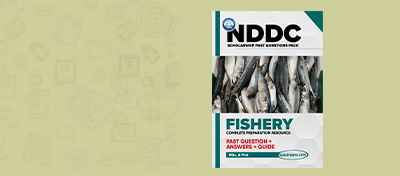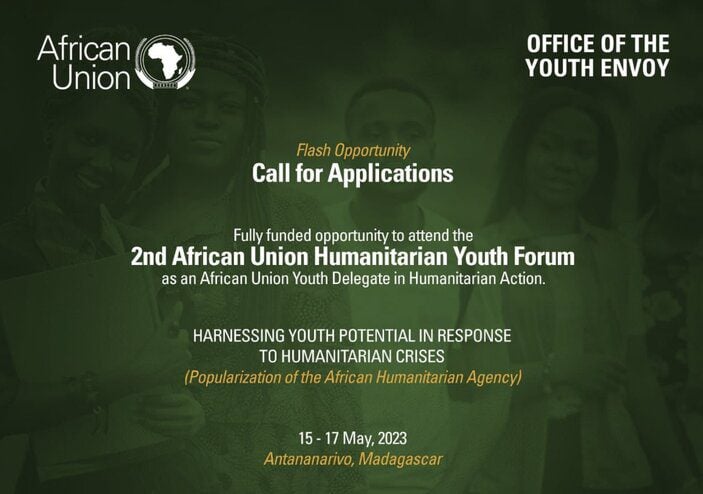NDDC Scholarship Fisheries Past Questions And Answers [Free – Download]
Are you an aspiring fisheries student with a passion for marine life and a dream of pursuing higher education in this field? The Niger Delta Development Commission (NDDC) Scholarship Program is your gateway to turning that dream into reality. We are excited to announce a special sale on NDDC Scholarship Fisheries Past Questions and Answers! This invaluable resource will help you prepare thoroughly for the scholarship exam, ensuring that you make a splash in the selection process and secure your path to success. Confidence is the lifeline of any successful examination performance. By practicing with actual past questions, you will gain the confidence needed to face the scholarship exam without apprehension. Familiarity with the exam format and question styles will put your mind at ease, allowing you to concentrate on showcasing your knowledge and expertise.
- Unlocking the Potential of Fisheries Education:
Fisheries play a crucial role in the economy and sustenance of communities in the Niger Delta region. As a result, the NDDC is committed to supporting bright and talented students like you, who wish to pursue higher education in this vital field. The NDDC Scholarship Program not only empowers you with financial assistance but also fosters the growth of future experts who will contribute to sustainable fishing practices and environmental conservation.
- Why Choose Fisheries Past Questions and Answers:
Preparation is the key to success in any scholarship examination, and the NDDC Scholarship Fisheries Past Questions and Answers offer the ideal way to gear up for the challenges ahead. This carefully curated collection provides an overview of past exam papers, ensuring that you are well-versed with the exam pattern, question types, and the areas that require special attention.
- Tailor Your Study Plan:
Our NDDC Scholarship Fisheries Past Questions and Answers allow you to customize your study plan to perfection. By reviewing previous exam trends, you can identify the subjects and topics that have been frequently covered, enabling you to allocate your time and efforts more efficiently. This targeted approach ensures that you cover all essential areas, giving you the edge over other applicants.
What Makes Our NDDC Scholarship Past Questions Stand Out?
- Comprehensive Coverage: Our collection spans multiple years, ensuring that you’re well-prepared for any surprises the exam might throw your way.
- Detailed Answers: Each question is accompanied by a comprehensive answer guide, allowing you to learn from your mistakes and reinforce your knowledge.
- Exam-Relevant Content: Our team of experts has painstakingly compiled the most relevant topics and questions that align with the NDDC Scholarship exam syllabus.
About NDDC Scholarship Test Style and Format (Updated)
NDDC overseas scholarship test was conducted by Cinfores-Ltd, between 2010 and 2015. Since 2016, the tests are now conducted by MEIL (MARG Educational International Limited).
The test usually comprises of 2 sections –
1. General questions which everyone will have to sit, and
2. Discipline-based questions.
For example, candidates in Engineering and Science related disciplines could take a mix of science-based questions like maths, English, physics, and chemistry for part 1, then discipline-specific questions for part 2.
2016 and 2017 tests contained more discipline-specific tests and English language tests as general papers. The test usually lasts between 30 to 60 minutes.
Sample Past Questions for NDDC Scholarship Aptitude Test – for FISHERIES candidates
1. What is the term used to describe the management of fish populations in order to ensure sustainability?
a. Aquaculture
b. Fisheries management
c. Overfishing
d. Habitat degradation
Answer: B. Fisheries management
2. Which of the following is not a common method used in commercial fishing?
a. Trawling
b. Gillnetting
c. Spearfishing
d. Fish farming
Answer: C. Spearfishing
4. What is the term used to describe the practice of catching and releasing fish for sport rather than for food?
a. Commercial fishing
b. Recreational fishing
c. Overfishing
d. Habitat destruction
Answer: B. Recreational fishing
5. What is the main reason for overfishing?
a. Increased demand for fish
b. Inadequate fisheries management
c. Climate change
d. All of the above
Answer: D. All of the above
6. What is the term used to describe the process of breeding fish in captivity and then releasing them into the wild to enhance natural populations?
a. Stock enhancement
b. Aquaculture
c. Overfishing
d. Habitat destruction
Answer: A. Stock enhancement
7. Which of the following is not a type of fishing gear?
a. Longline
b. Cast net
c. Fish finder
d. Fish trap
Answer: C. Fish finder
8. What is the term used to describe the unintended capture of non-target species in fishing gear?
a. Bycatch
b. Overfishing
c. Aquaculture
d. Stock enhancement
Answer: A. Bycatch
9. Which of the following is a sustainable fishing practice?
a. Overfishing
b. Discarding unwanted catch
c. Selective fishing gear
d. None of the above
Answer: C. Selective fishing gear
10. Which of the following is not a factor that contributes to the decline of fish populations?
a. Pollution
b. Climate change
c. Habitat restoration
d. Overfishing
Answer: C. Habitat restoration
11. What is the term used to describe the process of catching fish in a way that minimizes harm to the environment?
a. Sustainable fishing
b. Overfishing
c. Aquaculture
d. Habitat degradation
Answer: A. Sustainable fishing
12. What is a common method used in fisheries management to control overfishing?
a. Stocking more fish into the ocean
b. Increasing fishing quotas for commercial fishers
c. Implementing catch limits and size restrictions
d. Encouraging more recreational fishing
Answer: C) Implementing catch limits and size restrictions
13. Which of the following is the best way to prevent overfishing?
a. Implementing strict catch limits
b. Increasing the number of fishing vessels
c. Using larger fishing gear
d. Ignoring fishery management plans
Answer: A. Implementing strict catch limits
14. Which of the following is not a potential negative consequence of overfishing?
a. Reduced fish populations
b. Ecosystem imbalance
c. Increased seafood prices
d. Reduced food security
Answer: C. Increased seafood prices
15. What is the term used to describe the process of breeding fish in captivity for commercial purposes?
a. Stock enhancement
b. Aquaculture
c. Overfishing
d. Habitat destruction
Answer: B. Aquaculture
16. What is the term used to describe the practice of fishing for a specific species in a particular area?
a. Targeted fishing
b. Bycatch fishing
c. Recreational fishing
d. Commercial fishing
Answer: A. Targeted fishing
17. What is the term used to describe the unintended capture of non-target species in fishing gear?
a. Bycatch
b. Overfishing
c. Aquaculture
d. Stock enhancement
Answer: A. Bycatch
18. Which of the following is a type of sustainable fishing gear?
a. Bottom trawls
b. Drift nets
c. Longlines
d. Circle hooks
Answer: D. Circle hooks
19. What is the term used to describe the total amount of fish caught by a fishery?
a. Catch limit
b. Fish stock
c. Fishing effort
d. Total catch
Answer: D. Total catch
20. Which of the following is a potential consequence of illegal, unreported, and unregulated fishing?
a. Reduced fish populations
b. Ecosystem imbalance
c. Economic losses
d. All of the above
Answer: D. All of the above
1. What is the term used to describe the management of fish populations in order to ensure sustainability?
a. Aquaculture
b. Fisheries management
c. Overfishing
d. Habitat degradation
Answer: B. Fisheries management
2. Which of the following is not a common method used in commercial fishing?
a. Trawling
b. Gillnetting
c. Spearfishing
d. Fish farming
Answer: C. Spearfishing
4. What is the term used to describe the practice of catching and releasing fish for sport rather than for food?
a. Commercial fishing
b. Recreational fishing
c. Overfishing
d. Habitat destruction
Answer: B. Recreational fishing
5. What is the main reason for overfishing?
a. Increased demand for fish
b. Inadequate fisheries management
c. Climate change
d. All of the above
Answer: D. All of the above
6. What is the term used to describe the process of breeding fish in captivity and then releasing them into the wild to enhance natural populations?
a. Stock enhancement
b. Aquaculture
c. Overfishing
d. Habitat destruction
Answer: A. Stock enhancement
7. Which of the following is not a type of fishing gear?
a. Longline
b. Cast net
c. Fish finder
d. Fish trap
Answer: C. Fish finder
8. What is the term used to describe the unintended capture of non-target species in fishing gear?
a. Bycatch
b. Overfishing
c. Aquaculture
d. Stock enhancement
Answer: A. Bycatch
9. Which of the following is a sustainable fishing practice?
a. Overfishing
b. Discarding unwanted catch
c. Selective fishing gear
d. None of the above
Answer: C. Selective fishing gear
10. Which of the following is not a factor that contributes to the decline of fish populations?
a. Pollution
b. Climate change
c. Habitat restoration
d. Overfishing
Answer: C. Habitat restoration
11. What is the term used to describe the process of catching fish in a way that minimizes harm to the environment?
a. Sustainable fishing
b. Overfishing
c. Aquaculture
d. Habitat degradation
Answer: A. Sustainable fishing
12. What is a common method used in fisheries management to control overfishing?
a. Stocking more fish into the ocean
b. Increasing fishing quotas for commercial fishers
c. Implementing catch limits and size restrictions
d. Encouraging more recreational fishing
Answer: C) Implementing catch limits and size restrictions
13. Which of the following is the best way to prevent overfishing?
a. Implementing strict catch limits
b. Increasing the number of fishing vessels
c. Using larger fishing gear
d. Ignoring fishery management plans
Answer: A. Implementing strict catch limits
14. Which of the following is not a potential negative consequence of overfishing?
a. Reduced fish populations
b. Ecosystem imbalance
c. Increased seafood prices
d. Reduced food security
Answer: C. Increased seafood prices
15. What is the term used to describe the process of breeding fish in captivity for commercial purposes?
a. Stock enhancement
b. Aquaculture
c. Overfishing
d. Habitat destruction
Answer: B. Aquaculture
16. What is the term used to describe the practice of fishing for a specific species in a particular area?
a. Targeted fishing
b. Bycatch fishing
c. Recreational fishing
d. Commercial fishing
Answer: A. Targeted fishing
17. What is the term used to describe the unintended capture of non-target species in fishing gear?
a. Bycatch
b. Overfishing
c. Aquaculture
d. Stock enhancement
Answer: A. Bycatch
18. Which of the following is a type of sustainable fishing gear?
a. Bottom trawls
b. Drift nets
c. Longlines
d. Circle hooks
Answer: D. Circle hooks
19. What is the term used to describe the total amount of fish caught by a fishery?
a. Catch limit
b. Fish stock
c. Fishing effort
d. Total catch
Answer: D. Total catch
20. Which of the following is a potential consequence of illegal, unreported, and unregulated fishing?
a. Reduced fish populations
b. Ecosystem imbalance
c. Economic losses
d. All of the above
Answer: D. All of the above

Other Related Packs
PRODUCTION ENGINEERING.
PETROLEUM ENGINEERING
ELECTRICAL ENGINEERING
AGRICULTURAL ECONOMICS
CIVIL ENGINEERING
MECHANICAL ENGINEERING
ENVIRONMENTAL SCIENCE
MEDICAL SCIENCE
MANAGEMENT SCIENCE
EDUCATION AND HUMANITIES.
FISHERIES
GEOLOGY.
JOURNALISM
CHEMISTRY
CHEMICAL ENGINEERING.
BIOLOGY
COMPUTER ENGINEERING




